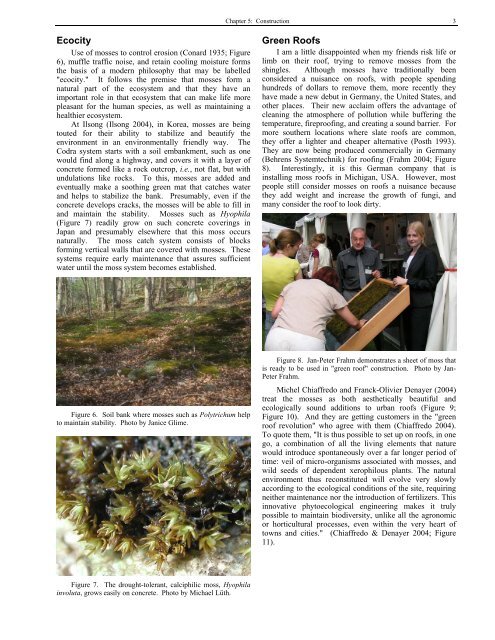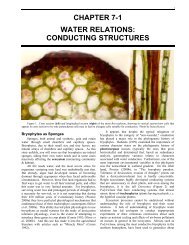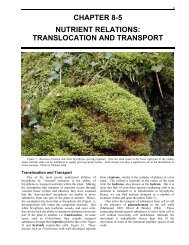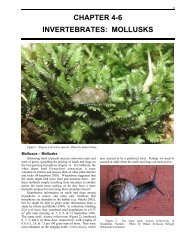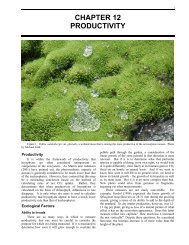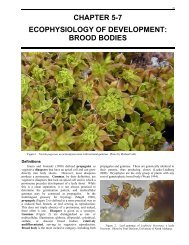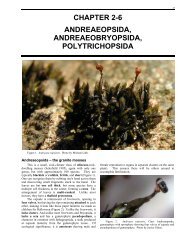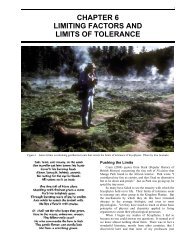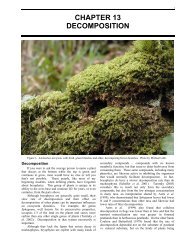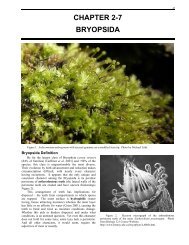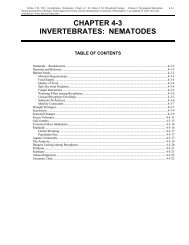Chapter 5: Construction - Bryophyte Ecology
Chapter 5: Construction - Bryophyte Ecology
Chapter 5: Construction - Bryophyte Ecology
Create successful ePaper yourself
Turn your PDF publications into a flip-book with our unique Google optimized e-Paper software.
Ecocity<br />
Use of mosses to control erosion (Conard 1935; Figure<br />
6), muffle traffic noise, and retain cooling moisture forms<br />
the basis of a modern philosophy that may be labelled<br />
"ecocity." It follows the premise that mosses form a<br />
natural part of the ecosystem and that they have an<br />
important role in that ecosystem that can make life more<br />
pleasant for the human species, as well as maintaining a<br />
healthier ecosystem.<br />
At Ilsong (Ilsong 2004), in Korea, mosses are being<br />
touted for their ability to stabilize and beautify the<br />
environment in an environmentally friendly way. The<br />
Codra system starts with a soil embankment, such as one<br />
would find along a highway, and covers it with a layer of<br />
concrete formed like a rock outcrop, i.e., not flat, but with<br />
undulations like rocks. To this, mosses are added and<br />
eventually make a soothing green mat that catches water<br />
and helps to stabilize the bank. Presumably, even if the<br />
concrete develops cracks, the mosses will be able to fill in<br />
and maintain the stability. Mosses such as Hyophila<br />
(Figure 7) readily grow on such concrete coverings in<br />
Japan and presumably elsewhere that this moss occurs<br />
naturally. The moss catch system consists of blocks<br />
forming vertical walls that are covered with mosses. These<br />
systems require early maintenance that assures sufficient<br />
water until the moss system becomes established.<br />
Figure 6. Soil bank where mosses such as Polytrichum help<br />
to maintain stability. Photo by Janice Glime.<br />
Figure 7. The drought-tolerant, calciphilic moss, Hyophila<br />
involuta, grows easily on concrete. Photo by Michael Lüth.<br />
<strong>Chapter</strong> 5: <strong>Construction</strong><br />
Green Roofs<br />
I am a little disappointed when my friends risk life or<br />
limb on their roof, trying to remove mosses from the<br />
shingles. Although mosses have traditionally been<br />
considered a nuisance on roofs, with people spending<br />
hundreds of dollars to remove them, more recently they<br />
have made a new debut in Germany, the United States, and<br />
other places. Their new acclaim offers the advantage of<br />
cleaning the atmosphere of pollution while buffering the<br />
temperature, fireproofing, and creating a sound barrier. For<br />
more southern locations where slate roofs are common,<br />
they offer a lighter and cheaper alternative (Posth 1993).<br />
They are now being produced commercially in Germany<br />
(Behrens Systemtechnik) for roofing (Frahm 2004; Figure<br />
8). Interestingly, it is this German company that is<br />
installing moss roofs in Michigan, USA. However, most<br />
people still consider mosses on roofs a nuisance because<br />
they add weight and increase the growth of fungi, and<br />
many<br />
consider the roof to look dirty.<br />
Figure 8. Jan-Peter Frahm demonstrates a sheet of moss that<br />
is ready to be used in "green roof" construction. Photo by Jan-<br />
Peter Frahm.<br />
Michel Chiaffredo and Franck-Olivier Denayer (2004)<br />
treat the mosses as both aesthetically beautiful and<br />
ecologically sound additions to urban roofs (Figure 9;<br />
Figure 10). And they are getting customers in the "green<br />
roof revolution" who agree with them (Chiaffredo 2004).<br />
To quote them, "It is thus possible to set up on roofs, in one<br />
go, a combination of all the living elements that nature<br />
would introduce spontaneously over a far longer period of<br />
time: veil of micro-organisms associated with mosses, and<br />
wild seeds of dependent xerophilous plants. The natural<br />
environment thus reconstituted will evolve very slowly<br />
according to the ecological conditions of the site, requiring<br />
neither maintenance nor the introduction of fertilizers. This<br />
innovative phytoecological engineering makes it truly<br />
possible to maintain biodiversity, unlike all the agronomic<br />
or horticultural processes, even within the very heart of<br />
towns and cities." (Chiaffredo & Denayer 2004; Figure<br />
11).<br />
3


